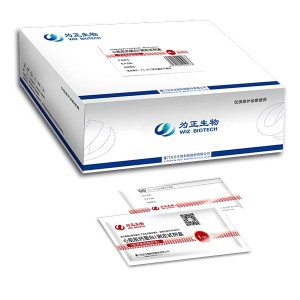Delaney, J. L., Doeven, E. H., Harsat, A. J. & Hogan, C. F. Use of a mobile phone for potentiostatic control with low cost paper-based microfluidic sensors. Anal. Chim. Acta 790, 56–60 (2013).
The assay was performed on a polycarbonate (PC) plate using a polydimethylsiloxane (PDMS) chip with embedded microchannels to form the binding strips, i.e., the test and control lines into which the reagents were added (see Methods) to create the barcode pattern shown in Fig. 1(b). The PC plate, after the photo-activation, was first modified with biotin moieties using NH2-PEG2-biotin (biotin moiety linked to terminal amine by polyethylene glycol spacer) via an amide coupling protocol. Nanogold-streptavidin conjugate was added before silver enhancement (gold nanoparticle-promoted silver deposition) as a means of signal amplification to give easily identifiable signal strips (to be analyzed by ODR). The dependence of ODR on the concentration of nanogold streptavidin conjugate was then determined (Fig. 3). Here, the increasing ODR trend is evident, with the signal reaching saturation between an ODR of 0.50–0.60, which corresponds to high concentrations (0.8 μg/mL) of the conjugate. At concentrations at or above 0.40 μg/mL of the conjugate, both “−” and “+” barcodes can be read by the scanner app. For the “+” barcode, as predicted from previous results, even low concentrations down to 0.20 μg/mL, “+” can be read; concentrations below 0.20 μg/mL can still be analyzed, but cannot be read by the scanner app for its encoded character.
“4. You pretend that you know me, that I lack compassion and live in fear. Where have you observed those traits in my comments? “
Peritoneal macrophages and BMMs isolated from wild-type, TLR4- and TLR2-deficient mice were pre-stimulated either with various doses of mMrp8 for 18 h or with 1 μg/ml mMrp8 for various time periods and re-stimulated with 5 μg/ml mMrp8, 100 ng/ml LPS, 100 ng/ml BLP, 5 × 104 CFU/ml heat-killed S. typhimurium or 7.5 × 104 CFU/ml heat-killed S. aureus for 6 h. Isolated human monocytes were pre-stimulated either with various doses of hMrp8 for 12 h or with 0.1 μg/ml hMrp8 for various time periods and re-stimulated with 5 μg/ml hMrp8, 100 ng/ml LPS, 100 ng/ml BLP, 5 × 104 CFU/ml heat-killed S. typhimurium or 7.5 × 104 CFU/ml heat-killed S. aureus for 6 h. BMMs isolated from wild-type, TLR4-deficient or TLR2-deficient mice were pre-stimulated with 1 μg/ml mMrp8 for 18 h and re-stimulated with 100 ng/ml LPS or 100 ng/ml BLP for 6 h. Cell-free supernatants were collected and stored at −80 °C until analysis. TNF-α and IL-6 concentrations in the supernatants were assessed by ELISA (eBioscience, Hatfield, UK).

Although CVB3-induced myocarditis had been considered to be CD4+ T lymphocyte–mediated inflammatory heart disease4,5, accumulating data indicates that macrophages represent the major inflammatory infiltrates and play a pathogenic role in the development of VM. Macrophages, as master regulators of inflammation, are highly plastic and can differentiate into M1 (classically-activated) or M2 (alternatively-activated) macrophages6,7 depending on signaling conditions. M1 macrophages, induced by lipopolysaccharide (LPS) and interferon-γ (IFN-γ), typically produce copious amounts of pro-inflammatory cytokines (tumor necrosis factor [TNF]-α, interleukin [IL]-12) and generate reactive oxygen species (ROS). As such, M1 macrophages are associated with inflammation and tissue destruction. On the other hand, M2 macrophages, induced by Th2-produced IL-4 and IL-13, secrete high levels of anti-inflammatory cytokines (IL-10) and are characterized by increased arginase1 (Arg-1) activity and surface expression of macrophage mannose receptor (MMR, CD206) and macrophage galactosetype C-type lectin (MGL, CD301). Functionally, M2 macrophages show an anti-inflammatory phenotype associated with tissue repair and angiogenesis8,9,10,11,12,13.
Sport and medical studies have consistently shown an increase in cardiac biomarkers during and following prolonged endurance exercise1,2,3. Besides exercise duration, its intensity is also a proposed significant contributor to cardiac troponin (cTn) release4. However, although repeated sprints (RS) are common in team sports and significantly contribute to athletic performance and aerobic fitness in other types of sport, their effect on the release of biochemical markers of myocardial damage has not been addressed yet. RS training (RST) is characterized by very short exercise bouts (maximal 30 seconds) of vigorous intensity and hence differs from long duration moderate intensity continuous training (MCT). While increases of cardiac troponin I (cTnI) were reported after high intensity continuous exercise (30 minutes)5, there was no evidence of a significant release of troponin cTn after high intensity intermittent exercise of short duration in adults6,7. Based on these findings, increased cTn after RS activities would suspect cardiac damage. However, little is known about the biomarker kinetics in relation to exercise intensities and durations as they frequently occur in sports such as competitive endurance training, handball, hockey, basketball, or other types of physical activity8,9,10. Further, while short duration intense exercise may impact on the release of cTn in adolescents11,12 this does not seem to apply to adults13.
The main infographic explains the recommendation and provides an overview of the absolute benefits and harms of screening at a 10 year time horizon for consistency and easier communication. However, the individual trials varied in their duration of follow-up from 10 to 20 years (fig 2), and we used the relative estimates of effect, pooled in the linked systematic review, at the longest available follow-up time.1 For the 10 year time horizon, we used as baseline risk in the non-screening arm of the CAP trial. It provided the most contemporary estimates of risks from a large sample of men representative of a general practice setting.2
좌장(진윤태): 함께 자리해 주신 소화기내과 선생님 및 같은 자리에 모시기 어려운 류마티스내과, 피부과, 소아과의 여러 선생님들을 모시고 자가 면역 질환인 건선, 관절염,염증성 장 질환에 대해 알아보고 치료 전략을 공유하는 좋은 자리였다. 참여해주신 선생님들께 감사 드린다.

The immunoassay market is growing at a five-year compound annual growth rate (CAGR) of 4.7%. Globally, it will reach a value of $21 billion by 2017, according to a new report from BCC Research, “Immunoassays: Technologies and Global Markets.”
BACKGROUND: Asthma and gastro-oesophageal reflux are both common medical conditions and often co-exist. Studies have shown conflicting results concerning the effects of lower oesophageal acidification as a trigger of asthma. Furthermore, asthma might precipitate gastro-oesophageal reflux. Thus a temporal association between the two does not establish that gastro-oesophageal reflux triggers asthma. Randomised trials of a number of treatments for gastro-oesophageal reflux in asthma have been conducted, with conflicting results. OBJECTIVES: The objective of this review was to evaluate the effectiveness of treatments for gastro-oesophageal reflux in terms of their benefit on asthma. SEARCH STRATEGY: The Cochrane Airways Group trials register, review articles and reference lists of articles were searched. SELECTION CRITERIA: Randomised controlled trials of treatment for oesophageal reflux in adults and children with a diagnosis of both asthma and gastro-oesophageal reflux. DATA COLLECTION AND ANALYSIS: Trial quality and data extraction were carried out by two independent reviewers. Authors were contacted for confirmation or more data. MAIN RESULTS: Nine trials met the inclusion criteria. Interventions included proton pump inhibitors (n=3), histamine antagonists (n=5), surgery (n=1) and conservative management (n=1). Treatment duration ranged from 1 week to 6 months. A temporal association between asthma and gastro-oesophageal reflux was investigated in 4 trials and found to be present in a proportion of participants in these trials. Anti-reflux treatment did not consistently improve lung function, asthma symptoms, nocturnal asthma or the use of asthma medications. REVIEWER’S CONCLUSIONS: In asthmatic subjects with gastro-oesophageal reflux, (but who were not recruited specifically on the basis of reflux-associated respiratory symptoms), there was no overall improvement in asthma following treatment for gastro-oesophageal reflux. Subgroups of patients may gain benefit, but it appears difficult to predict responders.
© 2015 Macmillan Publishers Limited. Background/Objective:Preservation of lung health requires understanding the modifiable risk factors of airflow limitation. This study investigates the association between diet and lung function in a population of Greenland Inuit residing in the Arctic (Greenland) or Western Europe (Denmark).Subjects/Methods:Two unselected Inuit populations were recruited, one living in Greenland (Urban (Nuuk) n=358; Rural (Uummannaq) n=207) and the other in Denmark (n=539). Lung function was measured using spirometry and diet by a food frequency questionnaire. Factors associated with airflow limitation were assessed using multiple linear regression models.Results:The dietary composition differed significantly in the two regions, with higher whale, seal and wild meat intake and lower fruit and vegetable intake in the Arctic regions compared with Denmark. Consumption of vegetables (P=0.004) and whale and/or seal (P<0.0001) was significantly and positively associated with FEV 1, as well as with FVC (vegetables: P=0.001, whale and/or seal: P=0.002). Regular fruit intake was included in the statistical models; however, it did not reach statistical significance (FEV 1: P=0.053; FVC: P=0.055).Conclusions:High dietary intake of vegetables as well as intake of arctic marine mammals had independent positive associations with lung function in this cohort of Greenlandic Inuit. These findings suggest an additive role of dietary intake of antioxidants and unsaturated fatty acids in lung health, which warrants prospective evaluation.
“When I started my career as an engineer I was initially incredibly dismissive of drivers but increasingly I’ve found myself having to tell engineers to listen to the driver. I find the whole dynamic very important.”
Only Conservative Use of PSA Testing Is Cost-effective 3090D553-9492-4563-8681-AD288FA52ACE Group 2 34A8E98B-62ED-4216-98D6-E986304F4C2E | Cpn-Igm Related Video:
To create much more benefit for consumers is our company philosophy; customer growing is our working chase for Respiratory System Test Kit , Procalcitonin Test Strip , Biochemistry Analyzer , We honor ourselves as a company that comprises of a strong team of professionals who are innovative and well experienced in the international trading, business development and product advancement. Moreover, the company stays unique among its competitors due to its superior standard of quality in production, and its efficiency and flexibility in business support.






